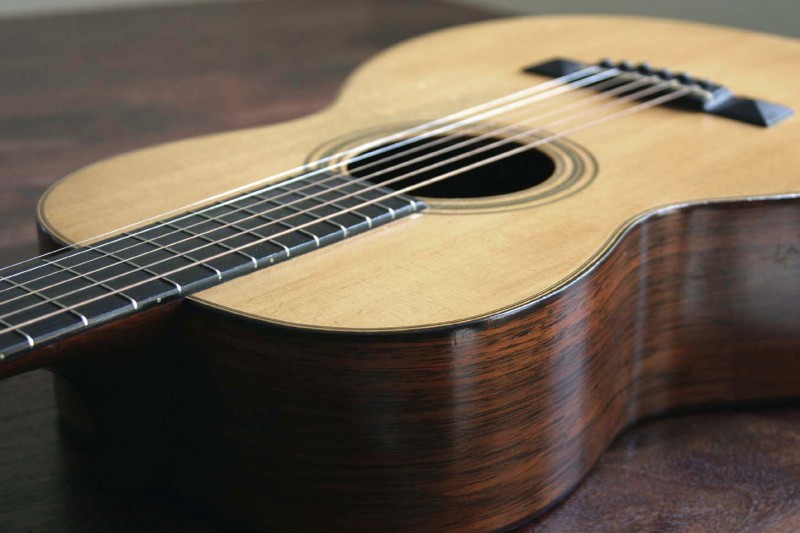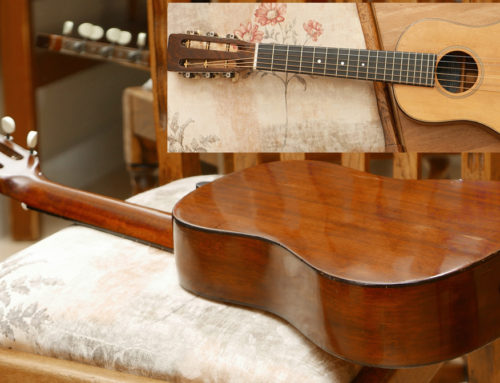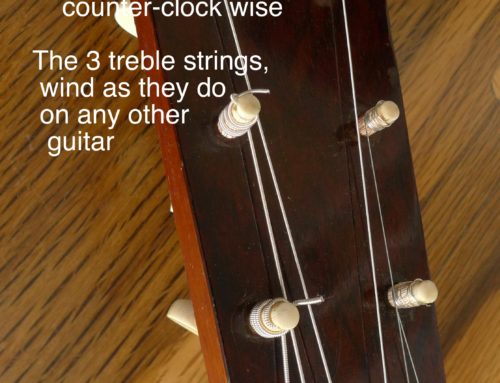Can I use steel strings on my vintage Martin guitar (or a guitar I am thinking of buying)?
That is one of the most common questions asked, about pre-1930’s Martin guitars and other Jazz age and earlier vintage guitars. And there is a lot of misconception and myth surrounding the issue.
The question often becomes, among Martin guitar lovers especially:
“In what year was (X) model Martin guitar, braced for steel?”
Remember that Martin came relatively late to the “steel string” acoustic guitar game. Martin, throughout their long history, came late to about all the innovations. That’s why Martin was such a great company– they resisted change for change’s sake. They were conservative German and German-American craftsman who liked doing things old-school. Gibson for example built guitars for steel strings decades before Martin did.
It’s difficult to tell if a 1920’s guitar was braced for steel strings by just looking inside it. The first “built for steel strings” martins were supposedly the small and inexpensive 2-17’s. (Hawaiian style guitars were always strung with steel strings, but the earliest of these (built in the late ‘teens) were not x-braced.)
So back to the question:
“In what year was (X) model Martin, braced for steel?”
Conventional wisdom (armchair Martin historians) says:
“ As Martin got more and more comfortable with steel string tension, the fancier and bigger guitars were designed for steels up until ’28 or ’29 when just about every instrument was designed for steel strings.”
Others posit, when looking at 1920’s Martins: “… The bridge plate is a clue. Very thin bridge plate = probably braced for gut strings. Thicker maple bridge plate= braced for steel.”
And, this timetable below, for Martin guitars, is often put forth as gospel:
Martin guitars, were ostensibly “braced for steel strings” from the factory, as follows:
• 1922– Style 17
• 1923– Style 18
• 1927– Style 21
• 1928– Style 28
• 1928– Style 40
• 1927– Style 42
• 1928– Style 45
But where did that timetable come from? From Martin company historian Mike Longworth’s book “Martin & Co, a History” the first edition of which was published in 1975. That list does not appear in that form, but “braced for steel strings” is addressed in the sections on each model.
The problem with that book, is that even Longworth did not stick to that gospel after that book came out and there were many many more 1920’s Martins being set up properly and played. Case in point, we have a personal letter written and signed by Mike Longworth, dated November 2, 1984, where ML refers to a specific Martin 1926 00-28 guitar, and he says that that particular instrument, by serial number, was designed for use with steel strings. ML was not looking at the actual instrument in-hand, but just responding to customer inquiry by serial number. Longworth was learning as he went, as we all do. To constantly cite a fairly rough first go at the Martin history from 1975– a half century later, as gospel– is just silly.
As for evidence of differences in bracing, top thickness, bridge plate thickness on Martin guitars from the 1920’s to give the definitive answer to the question? Many luthiers have looked in many an original 1920’s Martin guitars with all but an electron microscopes, and try as they might they can’t establish firm rules. Some evidence of patterns? Yes. Kinda. If you squint and cock your head to the left. Firm Rules? Not really.
We had a 1933 0-18K which was not only “braced for steel” from the factory according to the Longworth gospel, but for Hawaiian playing… and it’s original maple bridge plate was no thicker than the original bridge plate on an all-original Martin 1926 00-28– and that ’26 00-28 had been holding steel string for decades and it was 100% crack free, with no bellying behind the bridge whatsoever.
At the end of the day: many Martins made in the 1920’s (and some, before) hold light gauge steel strings fine. If an instrument has been holding them for a while– that’s the only test of a mid-20’s Martin, as to “can it should it will it hold steel strings”. Also, in that “transition” time in the mid-20’s it’s established now that some people were ordering “braced for Steel” models and those instruments were often produced outside the “timetable” and not designated as such in any Martin company records etc.
And consider: may Martins made in the 1930’s, 40’s, 50’s and beyond, have warping, bellying, cracks, etc. How to explain that? Yes, you could say they weren’t properly cared for over the years, but let’s face it, old Martin guitars, where built with light construction techniques, intentionally. The Martin guitars built before World War II were built to resonate, to perform, not to stay out of the shop and never need a neck set or a new bridge or other tweaking.
The Longworth “timetable” can be looked at with a very broad lens as a starting point, to answer the question of “is my Martin guitar ‘braced for steel strings’ “ but in addition to broad timetables/guidelines, proper, professional setup, and proper care of the instrument over the decades (humidity etc), are the best indicators of whether or not a particular instrument can support some kind of extra light, or light gauge steel strings used judicially.
No doctor could answer the question, “is my father, who is 80 years old, OK for a vigorous one-hour walk in the park, followed by an international flight through 4 time zones and 4 airports, pulling luggage behind him?” The doctor would have to examine the person in question. Some 80 year-olds are good for that and more. Others, have a hard time getting out to the garage behind the house and back.
And finally, the crucial factor almost always overlooked in this discussion of using steel strings on old guitars: the steel strings used prior to the 1930s were heavier gauge strings than what is commonly used today. The steel guitar string manufacturers of today make generally lighter gauge strings than in the first quarter of the 20th century, and they also make string of varying gauges, for every use. So you have to avoid comparing apples to oranges, in terms of string gauge in 2016 vs. 1916 or 1926.
We are NOT advocating a “let-it-rip” with steel strings approach. We love 1920’s and earlier Martins too much to ever advocate using anything but the right strings. Be careful, that’s the best advice. Consult experts if you have any questions. But we need to revisit some of the conventional wisdom about what guitars are “braced for steel”.



Leave A Comment